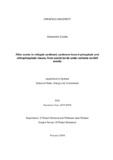JavaScript is disabled for your browser. Some features of this site may not work without it.
| dc.contributor.advisor | Simmons, Robert W. | |
| dc.contributor.advisor | Rickson, R. Jane | |
| dc.contributor.advisor | Sakrabani, Ruben | |
| dc.contributor.author | Cooke, Alexandra | |
| dc.date.accessioned | 2022-05-25T12:24:37Z | |
| dc.date.available | 2022-05-25T12:24:37Z | |
| dc.date.issued | 2018-02 | |
| dc.identifier.uri | http://dspace.lib.cranfield.ac.uk/handle/1826/17963 | |
| dc.description.abstract | Agricultural diffuse pollution is a major environmental issue within the UK. Within England alone, sediment and phosphates in agricultural runoff account for 2967 rivers failing their Water Framework Directive (WFD) water quality targets. Effective end-of-pipe solution sediment control measures include silt fences, buffer strips and berms. However, with the exception of buffer strips, these are not widely used in agricultural lands. Furthermore in terms of extreme rainfall events, their long-term efficacy is limited or unproven, as well as their ability to also remove orthophosphate. Filter socks (FS) are widely used as construction site sediment control within the USA, and could provide another mitigation option; however there has been limited testing for a UK environment, and their current fill media does not aid orthophosphate removal. Phosphorus sorbing materials (PSMs) are widely used within the wastewater treatment industry to remove orthophosphate. This research evaluated the efficacy of PSM amended FS to concurrently remove sediment, sediment-bound phosphate, and orthophosphate. In Phase 1, FS were evaluated in terms of their sediment removal ability, with and without a proprietary PSM, under UK agricultural field conditions. Runoff and eroded sediment was collected from erosion plots under a maize cropping regime. The 9-month replicated field trial results indicated variable results. The fill media produced an initial release of fines and orthophosphate after installation, although this declined over time. This flush event significantly increased the amount of sediment and orthophosphate found within the runoff of the FS compared to the runoff from the control, in sampling period 1. By the last sampling period, irrespective of fill-media (Woodchip or PAS 100 Compost), FS reduced runoff sediment load compared to the non-FS control. Orthophosphate removal was not increased by the addition of the proprietary PSM. Consequently a range of alternative PSMs were evaluated in Phase 2. Alternative PSMs were identified from a literature review. Their ability to remove orthophosphate was established through a fully replicated column experiment over a range of orthophosphate concentrations (0.08 – 1.30 mg P l⁻¹). The results indicate that ferrihydrite and goethite ochres were significantly more effective than all other treatments, with orthophosphate removal efficiencies ranging from 51 – 99 % and 32 –94 %, respectively. Furthermore the ferrihydrite ochre was the only PSM to reduce the orthophosphate concentration to below that of the water quality target for the Lugg river catchment (0.05 mg P l⁻¹). As the most effective PSMs, these were taken forward to Phase 3 where PSM amended FS were assessed for concurrent sediment, sediment-bound phosphate and orthophosphate removal under simulated laboratory experiments. Efficacy and performance was established across a series of replicated laboratory experiments using a rainfall-runoff simulator. These incorporated extreme rainfall events (80 mm hr⁻¹ intensity, 5 - 25 min duration), representing return periods of 5, 18,41, 74 and 126 yr for the Lugg catchment, Herefordshire. These used an erodible sandy loam soil that represented the dominant erodible soil type of the Lugg catchment, and a 17o slope representing the 80th Percentile slope for these erodible soils within the Lugg catchment. There were no significant differences in sediment removal efficiency between the treatments, irrespective of fill media (Woodchip or PAS 100 Compost), PSM (ferrihydrite ochre, goethite ochre, proprietary product), or rainfall event. Sediment removal efficiencies ranged from 66 – 97%. Treatments consistently removed up to 88% and 82% of eroded clay and silt sized particles, which is significant for the effective removal of sediment-bound phosphate. Ferrihydrite was the most effective PSM for orthophosphate removal with removal efficiencies of up to 34%. The 3 year trial indicated that more research is required to establish the wider validity of FS as a mitigation measure. This needs to encompass extensive field trials, incorporating their efficacy in other cropping situations with different soil types, slopes and climate conditions (e.g. annual rainfall). The research showed that PSM-amended FS are efficient at concurrently removing sediment, sediment-bound phosphate, and orthophosphate from runoff in laboratory studies, and are efficient under a range of laboratory based rainfall events. However this needs to be verified in field conditions to ensure that they remain a viable mitigation option for the future. Furthermore, research needs to be undertaken into the longevity of the materials for sediment and orthophosphate control in field conditions. | en_UK |
| dc.language.iso | en | en_UK |
| dc.rights | © Cranfield University, 2015. All rights reserved. No part of this publication may be reproduced without the written permission of the copyright holder. | |
| dc.subject | Diffuse pollution | en_UK |
| dc.subject | soil erosion | en_UK |
| dc.subject | phosphate | en_UK |
| dc.subject | ferrihydrite | en_UK |
| dc.subject | catchment management | en_UK |
| dc.title | Filter socks to mitigate sediment, sediment-bound phosphate and orthophosphate losses, from arable lands under extreme rainfall events. | en_UK |
| dc.type | Thesis | en_UK |
